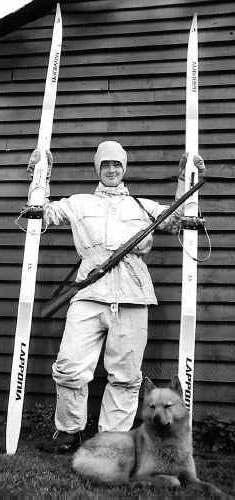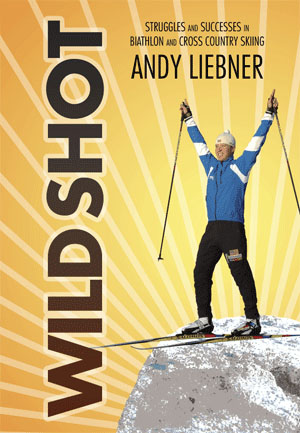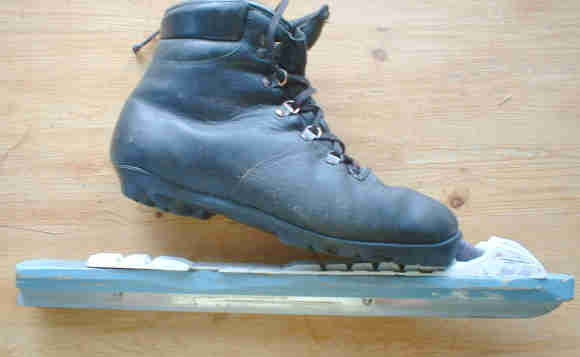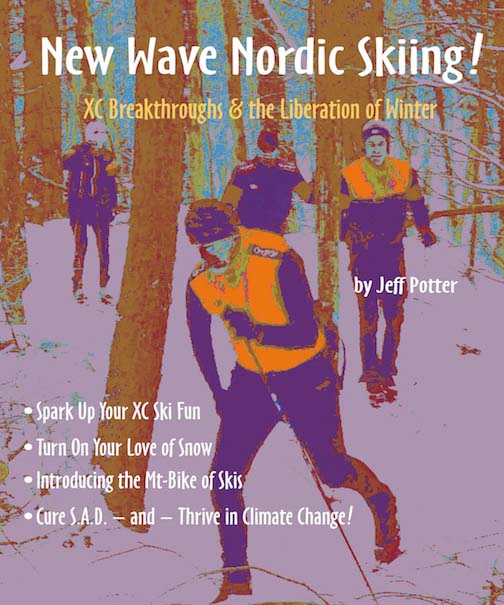A couple years ago I heard about a kind of ski that they had over in Scandiland that we don’t have here. The Forest Ski. It’s really long. It’s meant to be used on deep unbroken untracked open snow—like what we have here in Michigan on thousands of miles of 2-track trails in the boonies or in snowy fields in general. I find that my usual touring skis just sink too much in deep unbroken snow. Snowshoes float nice but don’t glide. I discovered the Forest Ski after looking for longer, wider skis meant to float and glide in deep snow. It turns out a couple current Finnish companies make these skis, Jarvinen and Peltonen. I then tried to get a friend who lives in Finland and visits mid-Michigan here every year to bring me a pair. I’d have the biggest XC skis in the USA, yo! What a thing to carry around on my roofrack all winter! I’d be proud to. They were only like $100. He said “Sure” but then dropped off the map. I think he’s in “Persia” now, though (for real). Anyway, here’s a translated report on this scene, followed by some links to more info and pics.
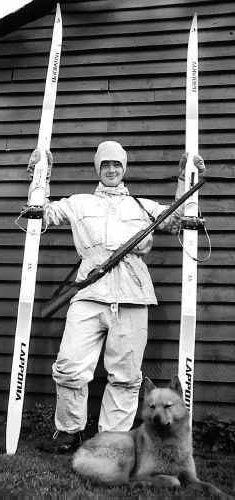
My online Google-Group request:
> Here’s a story on the Forest Skis in Finnish, but I can’t find an online
> Scandi>English translator. Can anyone tell us
> what it says about 280cm Jarvinen BC skis?
The helpful reply:
Here’s my amateur translation attempt, I’m just a wannabee Skandi so no guarantees on accuracy! –David Dermott
………………
LONG SKIS FOR COLD FOREST
For us who wander on foot in snowcovered lands without tracks or
ski-trails, there is afterall much to choose from. Mountain skis with
skins, snowshoes or short skis. What one chooses is much a matter of
taste. The tendency is to become shorter and narrower and lighter.
However there is much of this which does not keep the goal when snow is like powder, or when spring has come and the old snow is like a house of cards.
FOREST-SKIS
From old days forest-skis were heavy, long and broad. In Finland there
are still produced skis which are long and broad, but not heavy.
JÄRVINEN LAPPONIA are 280 cm long, 70 mm wide in the middle, and have wax-free soles which function well in wet snow. Mounted with a simple Swedish kandahar binding of KABY brand and weigh barely 5 kg for a pair.
These skis are meant for use on rotten snow and powder snow in flat
areas with good space. In cold February woods in N Sweden have winter
hunters and fotographers big use for such skis. Here is it usually
powder snow without “hold”, such that one steps to the bottom with all
kinds of aids except long, broad skis.
SOFT AS A BIRCHBRANCH
Skis are 280 cm long, 70 mm in middle and 65 cm in front depending
on what one defines as the tip.
The tip is namely very special with these skis in addition to that they
are somewhat longer than ordinary skis. The tip is soft as a
birchbranch, evenly narrowing on the upper 3/4 meter. The purpose with
this remarkable tip is that no matter how rotten or loose the snow is,
the tip will always be on the surface. Some of the original skis of
this type had tip at both ends in order to get the skis to float as much
as possible on the snow.
TRACKING OF BEAR
The skis are also well suited for wet and rotten spring snow during a
visit to “play-places”?? or during tracking of bears which
just have come out of their lair. A couple of years back should a
“slag”?? bear be killed on the spring snow in Pasvik in N Norway. The
inspector who should follow Arvo Sotkajervi during the hunt, must turn
back. He couldn’t manage to come forward on ordinary skis, while Arvo
quickly succeeded to overtake and kill the bear on his long broad Finnish
forest-skis.
I used skis of the same type on tracking of bear in rotten and wet
spring snow and covered 70 km in a short weekend. A tour which had been utterly tiring on regular skis, but with these skis were the tips always above the snow and the marching speed good.
OPEN and COLD
These type of skis assume somewhat open, flat terrain. Manouvers like
herringbone or snowplow turns are not simple. In totally loose powder
snow the carrying capacity is good at the same time the tips are always
over the snow.
As boots I prefer Nokian feltlined rubberboots with loose felt liners.
With this can I have 3 sock changes and 3 felt socks and the whole time
keep my feet dry and warm. Nokian boots are after my valuation better
suited for these skis than regular ski-boots in wet and rotten spring
snow.
For winter use are stiff telemark boots and telemark bindings
preferred. Skis are then easier to manouver.
……………….
Whew! More difficult than I thought. I had to consult dictionaries
and am still not sure of a few words!
—
David Dermott , Wolfville Ridge, Nova Scotia, Canada
WWW pages: www3.ns.sympatico.ca/dermott/
More Links to Stories and Photos of Forest Skis!
www.sll.fi/mpe/vodla/88Sy.JPG
www.sll.fi/mpe/vodla/92K.JPG
www.kolumbus.fi/laaksonen.jouni/tarinat/lemm98.htm
www.sll.fi/mpe/lapinmetsa/panoramas/index.html
